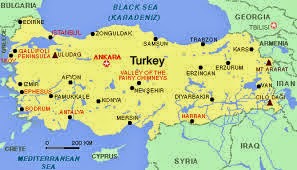The Republic of Turkey is a country of approximately 74 Million People located 97% in Asia and 3% in Europe. It has an incredible history dating back over 10,000 Years. Around 7500 BC the earliest known inhabitants were found at Atalhyk.
While modern Turkey is a relatively young republic having been founded upon the remains of the Ottoman Empire in 1923, it is an ancient land, the cradle of civilization and the center of world history. The Romans, Greeks, Persians, Ottomans, Macedonians, all have a very important role in Turkish History.
The site of the first human settlement; the seat of the Greek, Roman and Ottoman Empires; the last home of the Virgin Mary; the originator of yogurt and that presenter of coffee to the West - just a microscopic sampling of Turkey's extraordinary heritage. Anatolia is also birthplace of such historic legends as Omar the Poet, King Midas, Herodotus(Father of History), and St. Paul.
With its spectacular coastline, majestic mountains, cosmopolitan cities and quaint villages, today Turkey is one of the world's most desirable destinations, a captivating blend of East and West, antiquity and contemporary, the exotic and the familiar.
Turkish is the official language and is neither Indo-European nor Semitic. It belongs to the Ural Altaic group and is written using Roman Characters. The Ural-Altaic group is strongly related to Finno-Hungarian languages. English is widely spoken in major cities and resort areas.
Turkey's diverse typography allows its citizens and visitors a plethora of outdoor activities such as bicycling, boating, diving, golf, hiking, rafting, and skiing (snow and water). Anatolia's nearly 1,000 thermal springs have generated a number of spas and therapeutic facilities.
Turkey is about 99% Muslim, however it is a secular state and all religions can practice their beliefs freely. Temple of Artemus and Mausoleums at Halicarnassus are two of the 7 Wonders of the Ancient World. Built as a church, later a mosque, and now a museum. the Hagia Sophia was built by the Byzantines in the 6th Century.
The Turkish people are descendants of nomadic tribes from Mongolia and western Asia who moved westward and became herdsmen around A.D. 600. Early influence from the Chinese and Persians included noodles and manti , cheese- or meat-stuffed dumplings (similar to the Italian ravioli), often covered in a yogurt sauce. Manti has often been credited with first introducing dolma (stuffed foods) into the Turkish cuisine. The milk and various dairy products that became staple foods for the herdsmen were nearly unused by the Chinese. This difference helped the Turks to establish their own unique diet.

Turkish cuisine is often regarded as one of the greatest in the world. Its culinary traditions have successfully survived over 1,300 years for several reasons, including its favorable location and Mediterranean climate. The country's position between the Far East and the Mediterranean Sea helped the Turks gain complete control of major trade routes, and an ideal environment allowed plants and animals to flourish. Such advantages helped to develop and sustain a lasting and influential cuisine.
This week we decided to cook two classic Turkish Dishes. The first is a traditional Turkish breakfast consisting of Poached Eggs over Yogurt topped with Spicy Butter infused with Sage, Garlic, Red Pepper, and Paprika. It was absolutely delicious! The spicy butter was the most delicious topping to the rich savory eggs. We enjoyed it with pita bread. This Turkish delight was hearty, filling, delicious.
The second dish is a very common lunch meal in Turkey called Lahmajoun. It is a thin flatbread topped with a savory Lamb spread. The lamb is sautéed in so many fragrant herbs cumin, coriander, pepper, garlic, onions, and lots of fresh mint. Oh the smell in the kitchen when this was cooking was magnificent!

Tomato paste, crushed tomatoes are added and slowly cooked until the lamb reduces into a beautiful spread. It was heavenly!! The meatiness of the lamb, with the lovely mint and garlic was a combination I have never tried before. We made 4 Lahmajoun, they were gobbled up in minutes. We will definitely cook this meal again!

Tomato paste, crushed tomatoes are added and slowly cooked until the lamb reduces into a beautiful spread. It was heavenly!! The meatiness of the lamb, with the lovely mint and garlic was a combination I have never tried before. We made 4 Lahmajoun, they were gobbled up in minutes. We will definitely cook this meal again!
http://whttp://www.epicurious.com/recipes/food/views/Turkish-Poached-Eggs-with-Yogurt-and-Spicy-Sage-Butter-352
http://www.cookingwithlucy.com/categories/recipe/86-turkish-lamb-pizza-and-zaatar-flat-bread
http://www.cookingwithlucy.com/categories/recipe/86-turkish-lamb-pizza-and-zaatar-flat-bread








No comments:
Post a Comment